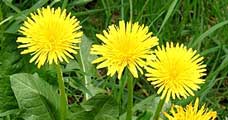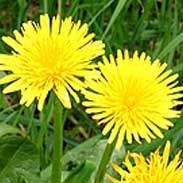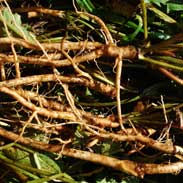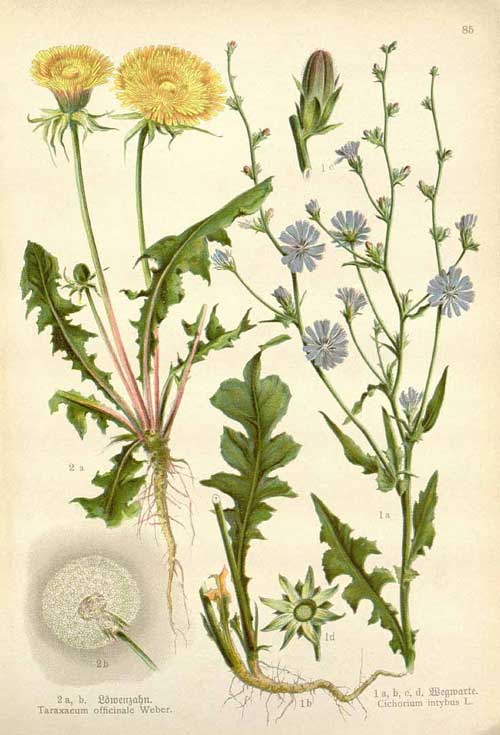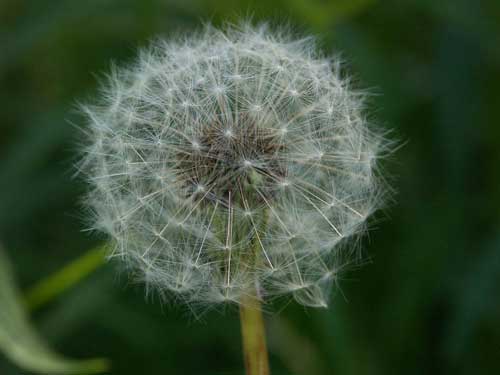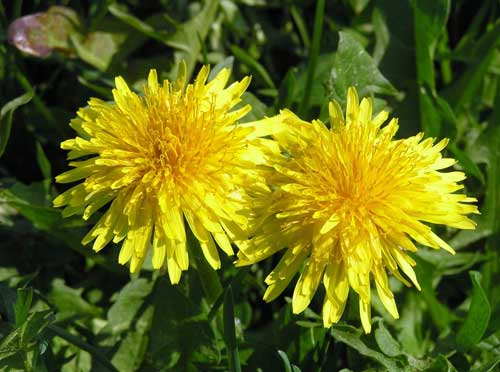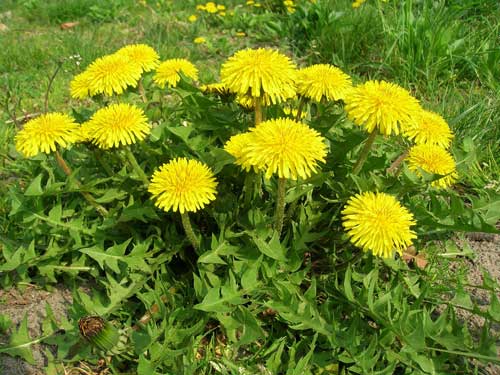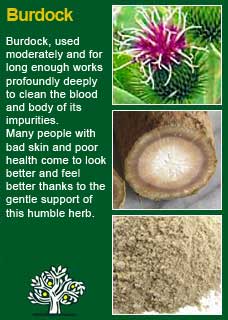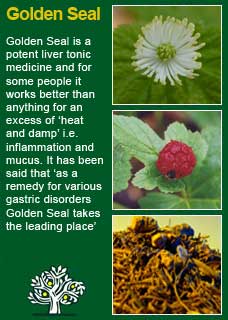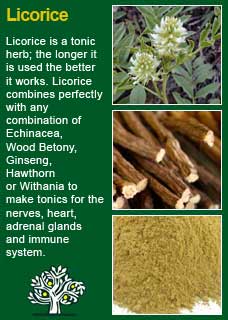
|
|
||||
| Our Pages ABOUT CONSTITUTIONAL MEDICINE
|
In herbal medicine we use the leaves and roots of Dandelion, a herb which everyone knows. Surely Dandelion is the most maligned of herbs; the bane of lawn-owners all over the world. Many of those same Dandelion diggers will be labouring under a liver congestion that, the weed they are trying to get rid of, could help more than anything!
Not surprisingly, Dandelion has been highly regarded everywhere in the world where people have used herbs as medicines. Dandelion root and its greens (the whole plant is medicinal) were used as tonics and liver medicines in European folk medicine from at least the time of the ancient Greeks. In the ancient Indian medical system known as Ayurveda, Dandelion is used to treat various liver disorders such as jaundice, cirrhosis of the liver and enlargement of the liver. Traditional Chinese medicine records Dandelion in use for at least 5 thousand years for a variety of conditions including diabetes, cancers, infections, fevers, snakebites and, of course, liver and digestive disorders. Nicolas Culpeper, over 400 years ago, wrote 'Dandelion has an opening and cleansing quality and therefore very effective for removing obstructions of the liver, gall-bladder and spleen and diseases rising from them. It openeth the passage or urine both in young and old and will cleanse ulcers. It is of wonderful help in cachexia'. (the wasting of severe illness). Maude Grieve writes 'in the hepatic complaints of persons long resident in warm climates, Dandelion is said to afford very marked relief. A broth of Dandelion roots, sliced and stewed in boiling water with some leaves of Sorrel and the yolk of an egg, taken daily for some months, has been known to cure seemingly intractable cases of chronic liver congestion. A strong decoction is found serviceable in stone and gravel: the decoction may be made by boiling 1 pint of the sliced root in 20 parts of water for 15 minutes, straining this when cold and sweetening with brown sugar or honey. A small teacupful may be taken once or twice a day. Dandelion is used as a bitter tonic in atonic dyspepsia, and as a mild laxative in habitual constipation. When the stomach is irritated and where active treatment would be injurious, the decoction or extract of Dandelion administered three or four times a day, will often prove a valuable remedy. It has a good effect in increasing the appetite and promoting digestion' The British Herbal Pharmacopoeia (BHP) describes Dandelion's actions as diuretic, laxative, cholagogue, antirheumatic and says it is indicated for gall-stones, jaundice, atonic dyspepsia with constipation, muscular rheumatism and oliguria (the production of abnormally small amounts of urine) Thomas Bartram writes 'Dandelion is a powerful diuretic, bitter tonic, pancreatic regulator, galactagogue (increasing breast milk) cholagogue (increasing the flow of bile) antirheumatic, pancreatic and bile duct stimulant, mild laxative, urinary antiseptic, anti-eczema, detoxicant, choleretic (increasing the volume of bile) and says it is indicated for liver disorders, inflammation of the gall-bladder, to counter tendency to form gallstones, to clear a yellowish complexion and brighten the eyes, to stimulate the flow of bile. Rudolph Weiss writes 'Dandelion is one of our oldest medicinal plants. It therefore comes as no surprise that it is recommended in a large number of diseases. Chronic disease of the metabolism and internal organs, especially gout and liver disease are some of the most consistent, long-standing indications for Dandelion and it is a fact that it is one of the best agents with which to intervene in chronic rheumatic disease'. T J Lyle writes 'Dandelion root, in order that you may experience its best effects, must be gathered during the late Summer months after it has accomplished its growth and before the freezing weather of Autumn begins. Boiling impairs its strength. It is a mild, slow, relaxing and stimulating tonic hepatic, influencing slowly the liver, digestive tract and kidneys. It assists digestion and assimilation. It influences the liver in both its secreting and excreting functions.
Andrew Chevallier write 'research published in the journal Planta Medica in 1974, confirms that Dandelion leaves are a powerful diuretic, though the exact mode of action is not undestood. Many other small scale studies have confirmed this diuretic effect. A 2004 laboratoroy study reported Dandelion root had marked anticancer activity, it significantly increased tumour necrosis factor and apoptosis' There have been a number of other studies on Dandelion in one form or another however I personally don't feel that any of them get even close to the heart of what this humble herb can do for us. Like jaundiced lawn-owners all the world over, they are looking at the Dandelion the wrong way! That said, for anyone who needs to complete an assignment or something, the following linked PDF file has the title, authors and publication details of about 60 studies on Dandelion and you should be able to access many of the abstracts etc by putting some of those details into your search engine, it's here
For some years now, against this proven and safe way of herbalism, there has been a rising tide of excessive caution and scare-mongering in many parts of the world. The same authorities that, not so long ago, decried herbal medicines as ineffectual, have now taken up a different adversarial position; that they are dangerous substances that should only be prescribed by Doctors, who of course have zero training in them. Unfortunately, the same unnecessary fear and worry has crept into many natural health websites and popular publications on herbs. Herbs that we have safely used for thousands of years, that have no reports of adverse reactions in the medical literature despite widespread use by millions of people, are suddenly described as contraindicated because of something that should have been seen as completely unimportant, or at the utmost a merely theoretical concern, such as a laboratory study on one of the herb's constituents to use an all too common example. I wonder sometimes if the writers of such articles feel that the herb will be more deserving of respect if it is thought to be a little bit dangerous, in other words more like a drug than something that has simply come out of the earth and been used by ordinary people for generations beyond count. There is just so much misinformation about herbal medicine on the internet now. Ludicrous claims and cautions abound in equal measure; it seems like one group are trying to make money out of the public whilst the other are busily trying to scare them off. I have to believe that the kind of reader who takes the time to read pages on herbs that are as extensive as this one is much less likely to be swayed by marketers or misinformers. I hope that you will keep your wits about you if you get conflicting opinions from people who have never really got to know these herbs, who have never worked with them, or learned how to use them safely and effectively. I want to remind you that the reason that herbs can never be patented and owned by any individual or corporation is because they are, and always will be, the People's medicine. They belong to all of us and it is my great hope in sharing this work that you will learn how to use them wisely for yourself, and the people you care for. Be safe, but do not be afraid.
My first herbal teacher, Dennis Stewart, always used to say, “Dandelion rinses the renal filter and squeezes the hepatic sponge” (renal means the kidneys and hepatic means the liver) Few adult people in the modern world do not benefit from some kidney rinsing and some liver flushing. I find that using some Dandelion in the formula helps everything else to work better and I use a very great deal of it in my work for the young or old, weak or strong who have chronic health problems that are being contributed to by a less than clean blood stream and a less than healthy liver! Dandelion is the first herb I think of for little infants who are having troubles getting their digestion working and so can be suffering from the agonies of colic or the terrible disruption of food allergies when, instead of starting to restrict foods, all the little person sometimes needs is some help getting their liver, and therefore their digestion, into gear, and they will often stop reacting adversely to their foods in a matter of days! Likewise, I almost always think of Dandelion when I meet teenagers and young adults whose skin is exploding with embarrassing acne. In these cases, it may take a treatment that needs a few months and I can honestly say that this has been a life-changing curative to a condition that can be frankly devastating to a person who is at one of the most vulnerable times in their life. I always combine it with Burdock root for this purpose. I also very often give Dandelion root to the people I meet who have not been eating well, are drinking too much or who are overworking. The liver takes an enormous amount of the brunt of the stress of such lifestyles and, whilst of course they still have to address where they are doing harm, Dandelion does a tremendous amount to help knit them back together in the meanwhile! Anyone reading this who is studying herbal medicine or who simply wants to understand these great plant allies at a much deeper level would do well to follow the old learning practice of taking a small dose of the tincture or decoction of Dandelion and then, with a quiet and attentive mind, closely observing how their body reacts to the herb. From doing this exercise myself on many occasions as well as with colleagues and students I think there is a rather good chance you yourself will become intrigued with this herb by how you feel what it does within. Perhaps this is the reason I didn't feel any of the scientific papers on Dandelion did it justice; it is a herb that changes things at a deeper level than you can measure or even easily describe. Try for yourself and see! Way back in the 1980s when I was first studying herbs this was the first medicine I made myself; from Dandelions dug out of our lawn and dried in the oven! I will never forget brewing it up and drinking the strong tea. It was like drinking in some kind of elemental energy; exotic, earthy and life-changing. Further to this, if you would like to learn more about the ancient art of pulse testing, a simple but powerful way to ask the intuitive intelligence of the body for its responses to a herb by feeling the pulse whilst giving a tiny dose by mouth, read here Dandelion root is very effective in decoction or equally as a tincture. Only small amounts are necessary to achieve all the benefits so long as it is kept up for long enough. For example, for a baby I might use just 4 or 4 drops of the tincture or 20mls of the tea. For a child perhaps around 1-2 mls of the tincture or half a cup of tea. For an adult, a good tsp of tincture a day or one strong cup a day. Dandelion leaf needs to be given in high doses (at least 8 grams a day) to achieve a diuretic effect and so it is best taken in a tea. A rounded tsp of the dried herb is about 4 grams. An example of how I use it in decoction along with Burdock root for treating acne is shown here. An example of a typical way in which I use Dandelion leaf in a cleansing tea to help the kidneys etc. is shown here and an example of a liquid extract within a liver formula is shown here Dandelion combines perfectly with Burdock for deep body cleansing. It works powerfully with Golden Seal, Celandine or Barberry for a congested liver and, for infants or children, a small amount of Licorice softens its bitterness and helps it to be absorbed.
The common name, dandelion, comes from the French, dent de lion, which means “lion’s teeth.” The original Latin (Dens leonis) and Greek (Leontodon) names for this plant bear the same meaning and these all refer to the familiar toothed appearance of the leaves. In Greek mythology, Theseus ate dandelions for 30 days to fortify himself to fight the Minotaur, a half man-half bull that ate the young adults of Athens.
Much of the information here about the traditional uses of Dandelion is consistent with the model of thinking whereby one may treat problem A with plant B. There is value in this approach, especially in how it helps us pass on useful knowledge to one another, but it falls short in one vital area; and that is that people are not all cut from the same cloth! Something that works brilliantly for one person may do less for another -- why is this? Part of the reason is that people vary in their constitutions as to whether they are either hotter or cooler and, at the same time, either dryer or damper. This useful and rather fascinating subject is introduced further here Another big part of using the right herb when it is most needed comes from understanding the need to treat what is going wrong for the person that had led up to their getting a health condition. In this light, Dandelion can particularly offer its benefits when a cleansing action is needed in the 'cycle of healing', more about this here
Please understand that I cannot advise you, including on products or dosage, without seeing you in person in my clinic but for ideas
on how you might find a good herbalist in your area read here |
|
|
© 2011 R.J.Whelan Ltd
